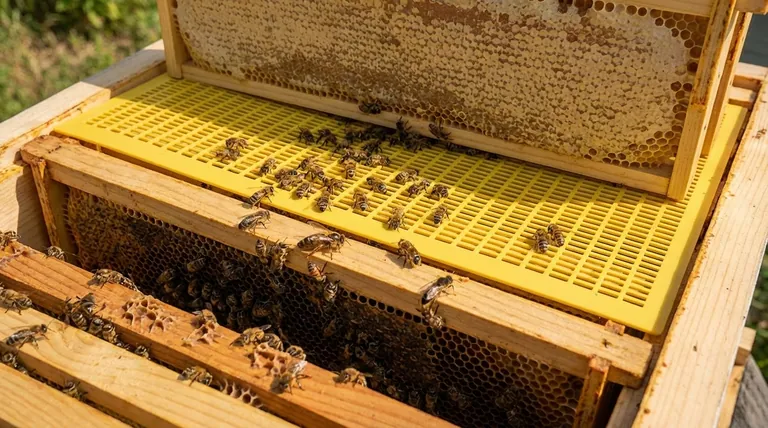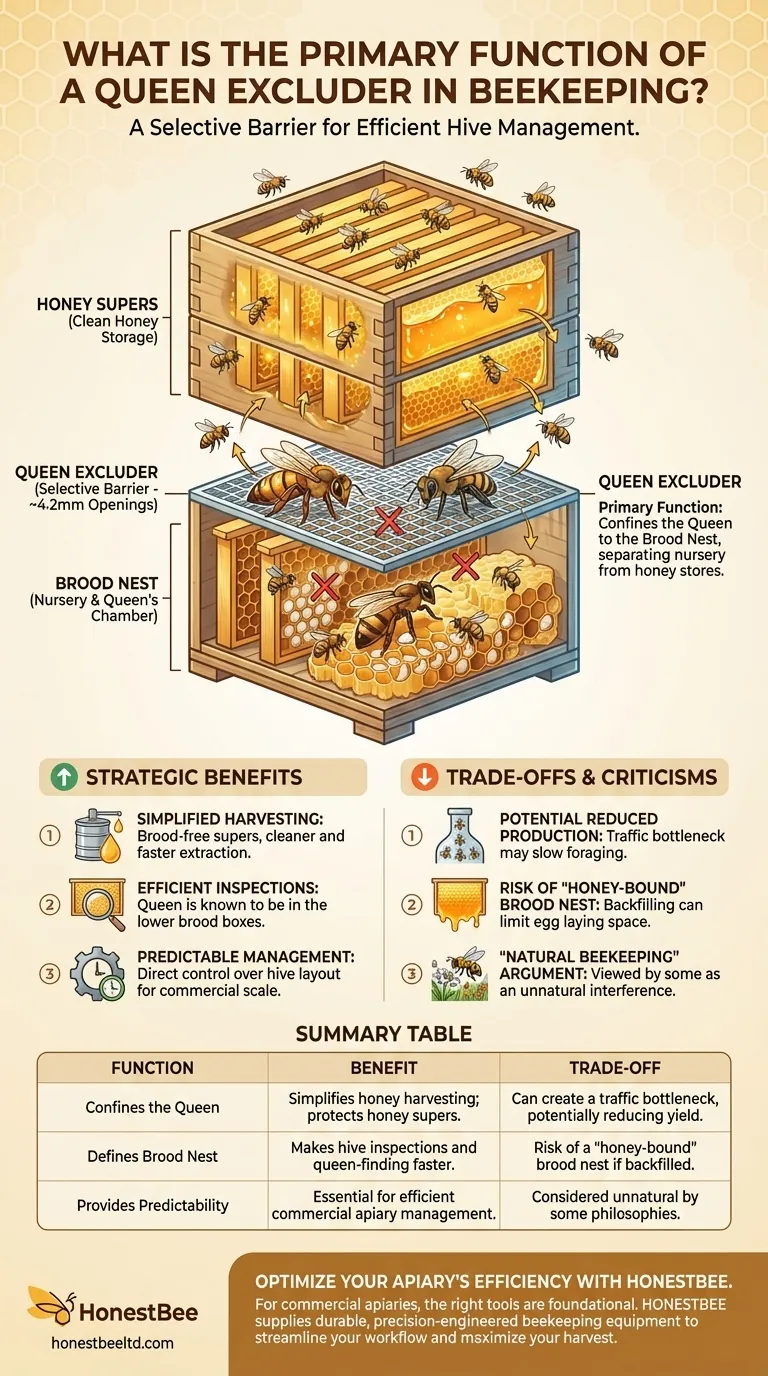At its core, a queen excluder is a selective barrier placed inside a beehive. Its primary function is to confine the larger queen bee to a specific section of the hive, typically the lower boxes known as the brood chamber. This allows the smaller worker bees to move freely throughout the entire hive while preventing the queen from laying eggs in the upper boxes, which are reserved for honey storage.
The central challenge in hive management is separating the queen's nursery (the brood nest) from the colony's pantry (the honey stores). A queen excluder is a tool that directly solves this problem, but its use involves a significant trade-off between management efficiency and the natural movement of the colony.

How a Queen Excluder Works
A queen excluder operates on a simple principle of size difference. It is a screen or grid with precisely spaced openings.
The Principle of Size Exclusion
The gaps in an excluder, typically around 4.2 millimeters, are large enough for worker bees to pass through. However, they are too narrow for the larger-bodied queen bee and male drones to fit, effectively trapping them in one area.
Defining the Brood Nest
By placing the excluder above the bottom hive box (or boxes), the beekeeper creates a dedicated brood chamber. The queen is confined to this area, and it becomes the exclusive nursery for the colony where all eggs are laid and young bees are raised.
Protecting the Honey Supers
The boxes placed above the excluder are called honey supers. Because the queen cannot access them, worker bees will fill these frames exclusively with nectar, which they then cure into honey. This ensures the honey crop is "clean" and free from developing bees.
The Strategic Benefits of Using an Excluder
For many beekeepers, especially in commercial operations, the excluder is an indispensable tool for efficiency and predictability.
Simplified Honey Harvesting
The most significant benefit is that honey supers remain completely free of brood. This makes the extraction process much cleaner and faster, as there is no risk of contaminating the honey with eggs or larvae and no need to carefully brush bees off frames containing sensitive brood.
Efficient Hive Inspections
When you need to find the queen, using an excluder narrows your search significantly. You know she is in one of the brood boxes below the excluder, saving you from having to search through the entire hive.
Predictable Colony Management
Using an excluder gives the beekeeper direct control over the hive's layout. This predictability is crucial for managing large numbers of colonies and streamlining workflows for feeding, treatment, and harvesting.
Understanding the Trade-offs and Criticisms
Despite its benefits, the queen excluder is a subject of debate among beekeepers. Its use is a choice with clear consequences.
Potential for Reduced Honey Production
Forcing worker bees to repeatedly squeeze through the barrier can slow their movement. This "bottleneck" may reduce the traffic of foragers into the honey supers, potentially leading to a smaller honey crop compared to an unrestricted hive. Some also claim the sharp edges of metal excluders can damage worker bees' wings over time.
Risk of a "Honey-Bound" Brood Nest
Sometimes, workers may be reluctant to cross the excluder and will instead store nectar in the brood chamber. This is known as "backfilling." If they fill empty cells around the queen with nectar, she will have no space left to lay eggs, which can severely limit colony growth.
The "Natural Beekeeping" Argument
Many beekeepers who practice a more hands-off, "natural" philosophy prefer not to use excluders. They argue it is an unnatural barrier that interferes with the colony's own instincts to organize its nest, believing a strong queen will naturally keep a consolidated brood pattern without intervention.
Making the Right Choice for Your Goal
The decision to use a queen excluder depends entirely on your beekeeping philosophy and objectives.
- If your primary focus is efficient honey harvesting: An excluder is an essential tool that guarantees brood-free honey and simplifies the extraction process.
- If your primary focus is a more "natural" or low-intervention approach: You may choose to manage without an excluder, allowing the colony to organize itself.
- If you are a new beekeeper: Using an excluder can make hive management much less intimidating and your first honey harvests significantly easier.
Ultimately, understanding the function and the trade-offs of the queen excluder empowers you to manage your hives in a way that best aligns with your goals.
Summary Table:
| Function | Benefit | Trade-off |
|---|---|---|
| Confines the Queen | Simplifies honey harvesting; protects honey supers from brood. | Can create a traffic bottleneck, potentially reducing honey yield. |
| Defines Brood Nest | Makes hive inspections and queen-finding faster and easier. | Risk of a "honey-bound" brood nest if bees backfill with nectar. |
| Provides Predictability | Essential for efficient management of commercial-scale apiaries. | Considered unnatural by some beekeeping philosophies. |
Optimize Your Apiary's Efficiency with HONESTBEE
For commercial apiaries and beekeeping equipment distributors, the right tools are the foundation of a successful and profitable operation. A queen excluder is a perfect example of a tool that provides critical control over hive management.
At HONESTBEE, we supply the durable, precision-engineered beekeeping supplies and equipment you need to streamline your workflow and maximize your honey harvest. Our wholesale-focused operations are designed to meet the demands of professionals like you.
Ready to equip your operation for peak efficiency? Contact HONESTBEE today to discuss your wholesale needs and discover how our equipment can contribute to your bottom line.
Visual Guide

Related Products
- Professional Plastic Queen Excluder for Modern Beekeeping
- Premium Wood Framed Metal Wire Queen Bee Excluder
- Wooden Queen Bee Excluder for Beekeeping
- Plastic Queen Bee Excluder for Bee Hive Wholesale
- High Performance Plastic Queen Excluder for Beekeeping and Apiary Management
People Also Ask
- How does a queen excluder work? Master Hive Management for Pure Honey Harvests
- What is the purpose of a queen excluder when adding a super? Streamline Your Honey Harvest
- What is a Queen Excluder and how does it work? Achieve Purer Honey & Better Hive Control
- What is the role of a queen excluder when adding a super? Ensure Brood-Free Honey Harvests
- What are the pros of using queen excluders? Boost Honey Production & Hive Efficiency



















